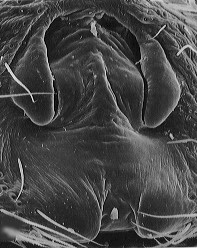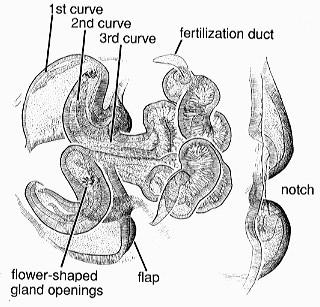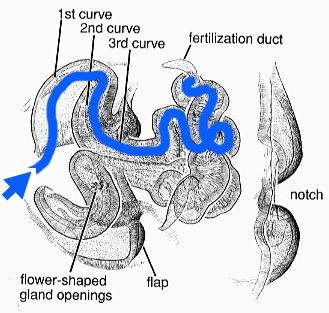Go to jumping spider anatomy page
A jumping spider female has a special hardened plate called the epigynum on the underside of her abdomen, up near her waist, into which the males put sperm using their palpi. In fact, the presence of this hardened, darkened spot is a good way to tell if you have an adult female spider. The epigynum has two openings into which the male inserts the tip
of his palpus. The surface of the epigynum is often sculpted, as can
be seen in this scanning electron micrograph:


The two openings are up near the top of the picture.
Inside the epigynum are some hardened ducts and reservoirs that transport
and store the sperm until the female is ready to lay eggs. Here is an
oblique view from the inside of the epigynum of a Pelegrina galathea,
showing the various tubes:


The path the sperm takes in entering the epigynum can be seen in the
following diagram, starting at the blue arrow:


The female holds the sperm inside until she is ready to lay eggs. As the eggs are leaving, they are fertilized with the sperm.
* Included on this page are images from Maddison, W.P. 1996. Pelegrina Franganillo and other jumping spiders formerly placed in the genus Metaphidippus (Araneae: Salticidae). Bulletin of the Museum of Comparative Zoology. l54(4): 215-368. These images are copyright © 1996 The President and Fellows of Harvard College
Jumping spider anatomy pages:
[Anatomy] [External] [Muscles] [Gut] [Vision] [Palpi] [Epigyna] [Gallery]


 Go to quick links
Go to quick search
Go to navigation for this section of the ToL site
Go to detailed links for the ToL site
Go to quick links
Go to quick search
Go to navigation for this section of the ToL site
Go to detailed links for the ToL site